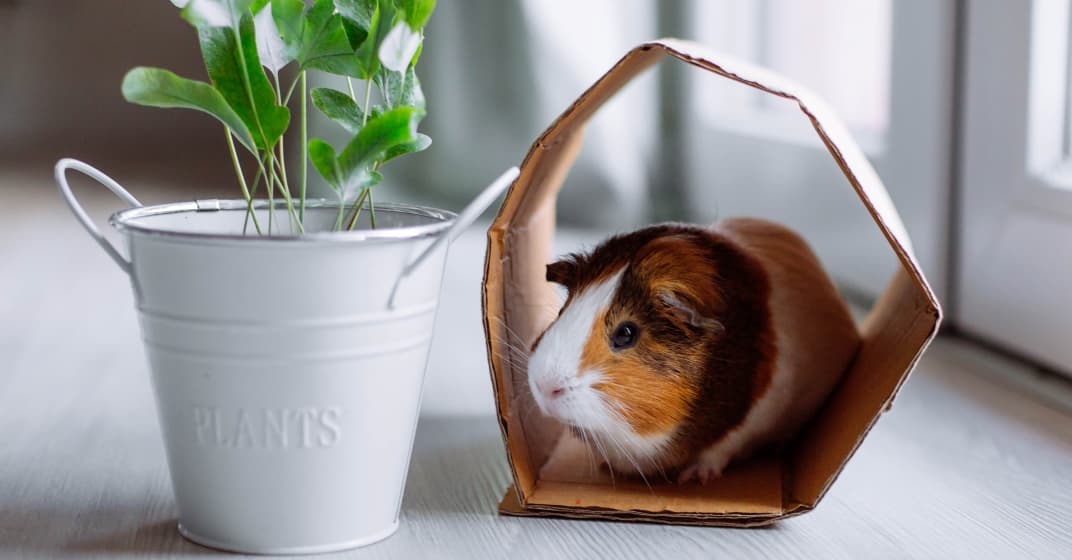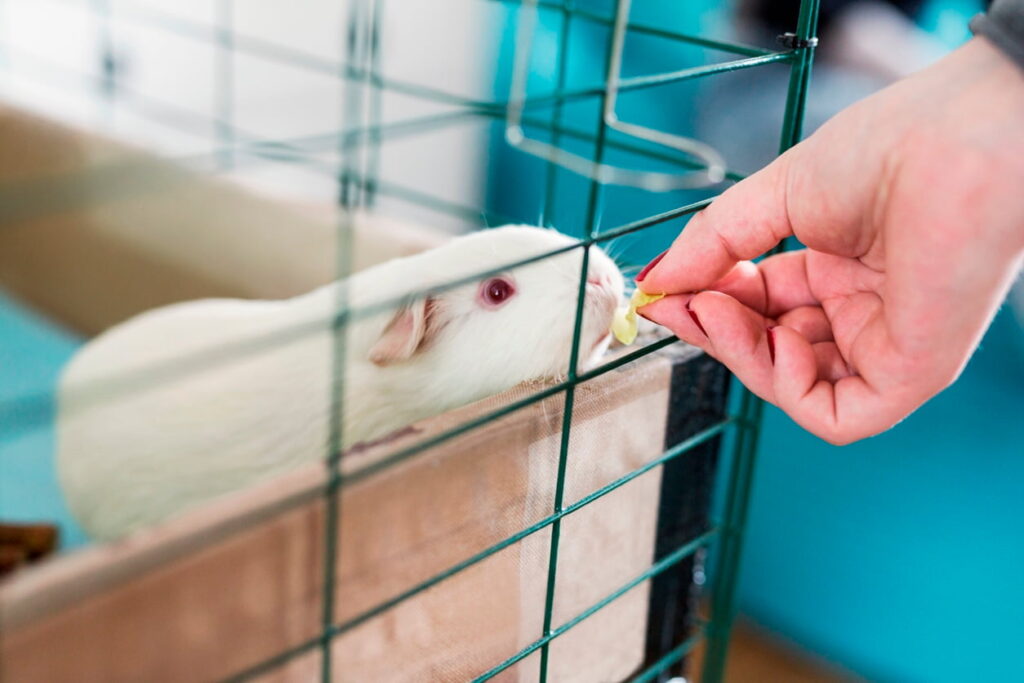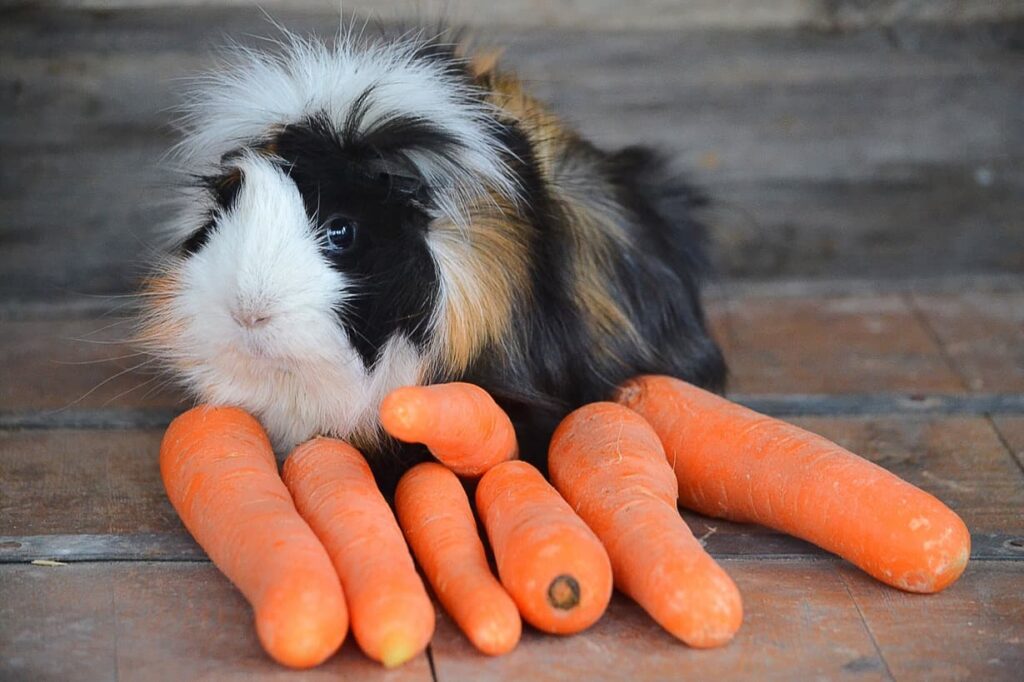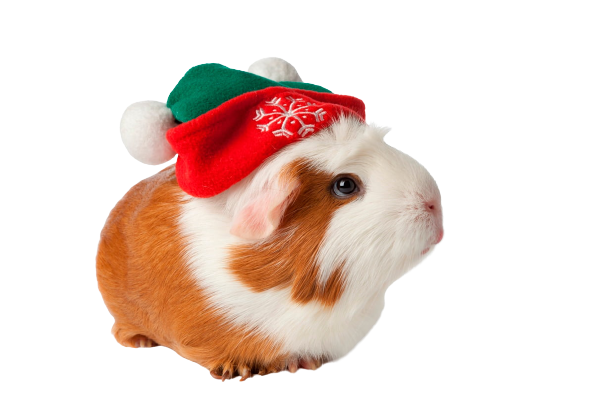How to take care of a guinea pig

Are you thinking of buying a guinea pig as your new pet? We will advise you on everything, that needs to be provided to make it feel really at home. Learn what are its characters and how to take the best care of it. You will find out what is the most suitable food for a guinea pig and how to ensure them the longest and most happy life with you and your family. We will also tell you what the differences between different species of guinea pigs are and how to take care of them differently. Guinea pig life has several pitfalls because of the diseases that can threaten them, so we will give you tips on how to take care of it, so that the disease does not even occur. We will also give you a few tips on the name of your new pet.
Contents:
Facts about guinea pigs that you should know
Guinea pigs are very sociable animals and they are often sad when they are alone, because they naturally live in packs. If you do not plan to cuddle them several times a day, you should buy them a friend with whom they will not feel so alone. Gender doesn't matter that much. There can be both two females and two males in the cage together. In the case of males, however, it really has to stay only with them in the cage. If we add a female, the males will start fighting for her favor and it could end by death of one of them. If those two males have not been together since they were little, it is recommended to castrate them. Of course, we can also have one male and one female in one cage, but we must reckon with the fact, that as soon as the female is pregnant, we will have to move her and her babies in another cage.
Guinea pigs are also sometimes called sea pigs. We could not find why, but the possible explanation is, that they came to us from across the ocean which is similar to piglets.
What is their nature?

The guinea pigs are cuddly and calm. We don't have to be afraid to let young children play with them, also, thanks to cute guinea pigs, they can form a generally good relationship with animals. The guinea pigs don't even have a developed bite defense reflex, so we don't have to worry about them hurting the children. If they are afraid of something, they do not bite, but they freeze. Although guinea pigs cannot harm children, children can sometimes harm them by hugging them tightly. Guinea pigs cannot defend themselves against this, so we should teach children how to treat guinea pigs properly. Guinea pigs are trusting animals that enjoy cuddling, and it is no exception, that they fall asleep on you while you rub them.
The guinea pig has a stereotypical nature and likes its habits. Therefore, it hates constant relocation and change of society. Its needs the owner to communicate with it several times a day and cuddle them. Otherwise, it can lead to social depression, which can lead to a loss of appetite, inactivity, etc. In some countries, it is even forbidden to buy only one guinea pig. Therefore, really make time for your pet, do not neglect it, and do not leave it alone for a long time.
In most breeds, males are larger and heavier than females. It weighs up to 2 lb. Females are smaller and weigh around 1 lb. They usually have thinner fur than males.
What are their senses?
A well-developed guinea pig sense is their sense of smell. They use it not only to recognize and select food, but also to differentiate members of their group (or owners) from others. Their eyesight is limited to a few colors, unlike the human. Guinea pigs can distinguish blue, green, red, orange, yellow and purple color. Their most developed sense is hearing. They are most sensitive to sounds in the range of 500 to 8,000 Hz, but they are also able to hear high frequencies (up to 33,000 Hz).
Cage or plastic box?
The cage or plastic box for guinea pigs should be at least 30 x 20 x 15 inches, but ideally, of course, the bigger the better. The lower part of the cage should be about 5 inches high so that the bedding does not fall out of the cage, but at the same time so that the guinea pig has a good view from the cage. Cages tend to be airy, easily portable, and easy to clean. However, their disadvantage may be the fact, that it tends to be cold in there, which guinea pigs are prone to. With a cage, bedding could be thrown out and the guinea pigs can ground their teeth against the metal bars, which is not exactly quiet. The second option are terrariums and plastic boxes, which are more affordable. The guinea pig is more covered, so it stays warm, but on the other hand, sometimes there is a problem of air ventilation. If the box is not well ventilated, the air in the box can contain a higher amount of ammonia, which can promote respiratory diseases. The guinea pig cannot throw the bedding out of these boxes, which is a significant relief for the owner when cleaning.

Where to place the cage?
Because guinea pigs are very friendly, they would like to be where most people meet and where it will be in as much social contact as possible. The living room is an ideal place for them, because during the day they will be surrounded by household members, but sometimes they make noise at night which would not please us in the bedroom in the middle of the night. The cage should not be exposed to direct sunlight or in places where the temperature is higher than 77 ° F, as guinea pigs are prone to overheating. We should also find a place with no wind blowing on the guinea pig or without too much noise. Therefore, it is not good to place the cage near a television or loud radio.
In summer, it is possible to take the cage to the garden or accommodate the guinea pig in a rabbit hutch. It is not necessary for its enclosure to have a roof, as guinea pigs are not the best jumpers, but we must not forget about a place where our pet can hide when it is too hot or when it starts to rain. If we have a guinea pig in a paddock without a roof, we should watch over, so some cat, fox or dog do not mess with the guinea pig. If we leave him outside overnight, we must adjust the cage so that the wind does not blow on him. The ideal temperature for guinea pigs is 63 to 77 ° F. As long as the guinea pigs are in a cage, they usually do not dig burrows. But that can change when we leave them in the outdoor enclosure, so we should secure the enclosure so that the guinea pig does not dig out.
Guinea pigs like their stereotypes and therefore frequent moving is not very ideal for them.
What must not be missing in every cage?
The cage must not lack a house in which the guinea pig can hide at any time. It is an important part of the cage as it provides the guinea pig with security and privacy. It is a great protection for him when, for example, the sun starts to shine too much, or it wants to hide from the wind.
We can line the bottom of the cage with wood shavings, torn paper, straw, or torn newspapers, but only if it is not solid advertising paper. A healthy guinea pig produces a large amount of feces, so it is necessary to change the bedding regularly. At the same time, however, they are very clean animals that clean themselves several times a day.
Ideally, there should be a heavy bowl of water in the cage, which the guinea pig will not simply turn over so that it does not spill. Sometimes, however, this can happen, or the bedding gets into the bowl. Therefore, it is better to buy a drinker, so that our pet always has enough fresh water. Guinea pigs like to poop in their bowls with water, so it is advisable to place a hanging system – drinkers with water and food in the cage.
Guinea pigs are very active, so they also need toys in addition to the basic things in their cage. They like various tunnels, shelters, biters, or hay toys.
We can also put a hanging bed or hammock in the cage, in which the animals can rest.
The guinea pig likes its cage, but it is also a pleasure for it to run outside. Therefore, we should allow it to take some time every day in a looser enclosure, for example around the room or in a smaller enclosure on the floor, which can be easily cleaned. Our pet should have enough space in the cage to move freely. For fun, we can also put a toy or a tunnel in his cage. Guinea pigs are smart, and they can be trained. They can learn to stand on their back, jump up or turn around on command.
Guinea pig food

The guinea pig is a herbivore, so we feed it a plant-based diet. Its diet should include vegetables, fruits, green granules, and hay. Guinea pigs need to graze, so plenty of hay and grass is important. If we do not provide them with this food, they may have problems with digestion after some time.
It is advisable to give food to our pet at the same time every day. We can set a fixed hour, for example, before we go to work in the morning. If you give the guinea pig fruit or vegetables, which we store in the refrigerator, it is advisable to check whether it’s not too cold. If the guinea pig doesn't eat some piece, we'll pull it out of the cage after a while, so it doesn't get moldy. Sometimes we can also put a mineral bar or hard bread into the cage, which will be used by the guinea pig to grind its teeth.
The supply of vitamins, which we can ensure in several forms, is essential for the health of a guinea pig. We should not forget vitamin C, which we can give our pet in the form of vitamin drops, which we drip into the water, or in the form of tablets. However, it is advisable to provide him with fresh fruits and vegetables, from which it will obtain the necessary vitamins in a natural way. We should feed the guinea pig with granules as little as possible. If we are not sure if we give the guinea pig everything it needs, we can consult a pet store or get special feed mixtures for guinea pigs straight away.
Summary of feed for guinea pigs
- hay and grass
- vegetables – celery, sweet dill, corn leaves, etc.
- fruits – grapes, kiwi, strawberries, banana, orange, pineapple, etc.
- herbs – meadow fescue, bushy broom, meadow clover, etc.
- seeds – goji = Chinese gooseberry, flaxseed, quinoa
- vitamin C
Babies
Guinea pigs are bred on average three times a year and females carry their babies for 68 days. They are born fully developed and they drink breast milk for about 4 weeks, but after a few days they start biting into small pieces of ordinary food. The small guinea pigs stop drinking breast milk from the mother after about six to seven weeks.
Guinea pig health
If we take good care of the guinea pig, we significantly reduce its susceptibility to diseases. The most common problem that guinea pigs suffer from are skin mites, that get on them from the hay, which we use to line their cages. These mites cause the guinea pig itching, and by scratching, the guinea pig makes scabs on its skin. Fortunately, treatment is not complicated. Just take your pet to the vet, who will solve the problem with an anti-mite injection. Some diseases affecting guinea pigs can be significant. If the guinea pig does not have enough vitamins and minerals, it can have deformed teeth and jaw. Therefore, we should not underestimate his diet and not skimp on low-quality mixtures.
Once every few weeks it is necessary to cut the guinea pig's claws. If we don't know how to do this, we can consult the vet, who will teach us to cut claws so that we do not harm the guinea pig.
Species of guinea pigs
There are countless species of guinea pigs such as smooth-haired guinea pigs, rosette guinea pigs, etc., let's look at the most interesting and widespread not only in the world, but also in the Czech Republic.
Cuy guinea pig
Cuy guinea pig, or otherwise called a giant guinea pig, weighs about 4.5 – 6.5 lb. It differs from the classical guinea pigs by the number of their fingers, which was originally a genetic defect that developed due to its huge figure. To breed them, we need a larger cage, and we should also ensure that the guinea pigs run regularly around the garden or at least around the apartment. This species of guinea pig is strongly fixed on its owner and his family. They can therefore sometimes be cautious about unknown visits. Cuy guinea pigs eat more food than the classic guinea pigs. However, we should not overdo it with food, as it is then at risk of obesity or heart failure. We can choose cuy guinea pigs according to the color or length of their fur- short or long.
Skinny guinea pig
Skinny or hairless guinea pig was bred in the 1980s and is not very well known in our country. His skin is soft, and the guinea pig is easy to tame, it likes to be cuddled and is intelligent. Unlike classic guinea pigs, they are more communicative and cuddlier, which means higher demands on the care. The care is more demanding in terms of finances, but also in terms of knowledge. If we want to buy this kind of guinea pig, we should buy two at a time so that it doesn't suffer. Because of their special skin, it is advisable to use quality bedding, that is dust-free and sterile, those beddings are sold for breeding laboratory animals. We can keep the skinny guinea pigs only inside and we must not expose it to drafts or the outdoor climate. We feed them several times a day and we should also clean the bedding and cage more often.
Peruvian guinea pig
The long-haired or Peruvian guinea pigs are popular in our country. It has a shiny and soft fur, which we should brush and comb regularly. Precisely because of their fur, it is better to keep this species of guinea pig on hay rather than on regular beddings. If the guinea pig has an overgrown fur, it may get tangled, which is not comfortable for it. That's why we can cut it occasionally to reduce the time spend on combing it and at the same time we make it easier for him to move.
The guinea pig has many relatives in the animal world, such as nutria, steppe mara, agouti, but also capybara, which can weigh up to an incredible 130 pounds.
Name for guinea pigs
The right name for our pet often comes to mind when we look at it. It is a name that suits its appearance, for example: Chubby, Fluffy, Snowflake, Bubble, Cutie, Honey, etc. We can also choose according to the classic name calendar, which will give us a lot of inspiration. Good ideas for names are the ones that we have heard somewhere. For example, in our favorite movie, series or book. Such names may be: Andy, Danny, Eddie, Freddy, Amy, Ashley, Ginny, Lucy, Wendy, Sindy, etc.
Life expectancy and death
Guinea pigs live about 4 to 10 years. It depends on how well we take care of them, what diet we feed them and what their genetics is like. Life expectancy may also vary depending on the species of the guinea pig. Some guinea pigs even live to be 15 years old.
The most common health complications that guinea pigs suffer from are various allergies to bedding or dietary components, worms- which occur from food, diarrhea, or flatulence. However, these are complications that we can cure with the help of a veterinarian very quickly. Far more serious diseases like leukemia or paratyphoid, occurs in guinea pigs that live near rats and mice. Then there are tumors, or loss of appetite, which are often caused by stress.


0 Comments